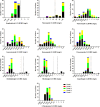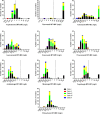Evaluation of the MIC test strips for antifungal susceptibility testing of Candidozyma auris (Candida auris) using a representative international collection of isolates
- PMID: 40608317
- PMCID: PMC12345157
- DOI: 10.1128/jcm.00399-25
Evaluation of the MIC test strips for antifungal susceptibility testing of Candidozyma auris (Candida auris) using a representative international collection of isolates
Abstract
We compared MIC test strips (MTS) with the reference Clinical and Laboratory Standards Institute (CLSI) broth microdilution method using an international panel of 100 Candidozyma auris (Candida auris) isolates belonging to different clades. The agreement (±1 twofold dilution) between the methods and the categorical agreement (CA) based on the Centers for Disease Control and Prevention's (CDC's) tentative resistance breakpoints and MTS-specific wild-type upper limit values (WT-ULVs) were determined. The MTS-CLSI agreement was poor to weak for posaconazole (3%), itraconazole (20%), voriconazole (31%), and 5-flucytosine (37%), and moderate to strong for isavuconazole (58%), anidulafungin (68%), caspofungin (72%), micafungin (77%), and amphotericin B (85%). Most fluconazole MICs were off-scale, precluding a corresponding estimation. Significant interpretation discrepancies were recorded using the CDC's breakpoints for amphotericin B (66% CA, 34% major errors; MaEs), but not for fluconazole (98% CA, 1% MaEs, 1% very major errors; VmEs), anidulafungin (97% CA, 3% MaEs, 0% VmEs), micafungin (99% CA, 1% MaEs, 0% VmEs), and caspofungin (95% CA, 5% MaEs, 0% VmEs). Discrepancies were minimized using the amphotericin B method-specific WT-ULV of 4 mg/L (98% CA, 2% MaEs). The MTS-specific WT-ULVs of echinocandins could help to detect 100% of FKS1 mutants. MTS generated higher MICs than the CLSI for azoles and 5-flucytosine. MTS could accurately detect fluconazole and echinocandin resistance among C. auris isolates. Nevertheless, it overestimated amphotericin B resistance as per the CDC's breakpoint of 2 mg/L. This can be improved by using the MTS-specific WT-ULV of 4 mg/L.IMPORTANCECandidozyma auris (Candida auris) may exhibit resistance to multiple and sometimes even all currently available classes of antifungals. Hence, antifungal susceptibility testing (AFST) is of key importance to guide the clinician in therapeutic decision-making and to detect novel patterns of resistance. Gradient diffusion strips, referred to both Etest and MIC test strip (MTS), are broadly used in laboratory routine for AFST of yeasts. We therefore compared MTS with the reference Clinical and Laboratory Standards Institute (CLSI) broth microdilution method using an international panel of 100 C. auris isolates belonging to different clades. Significant interpretation discrepancies were recorded for amphotericin B (66% categorical agreement, 34% major errors), which could be minimized using the amphotericin B method-specific wild-type upper limit value of 4 mg/L. MTS generated higher MICs than the CLSI for azoles and 5-flucytosine. MTS could accurately detect fluconazole and echinocandin resistance.
Keywords: Candida auris; MIC test strip; antifungal susceptibility testing; resistance; wild type upper limit values.
Conflict of interest statement
The authors declare no conflict of interest.
Figures




References
-
- Kim HY PhD, Nguyen TA MSc, Kidd S PhD, Chambers J MD, Alastruey-Izquierdo A PhD, Shin J-H MD, Dao A PhD, Forastiero A MD, Wahyuningsih R MD, Chakrabarti A MD, Beyer P, Gigante V PhD, Beardsley J PhD, Sati H PhD, Morrissey CO PhD, Alffenaar J-W PhD. 2024. Candida auris-a systematic review to inform the world health organization fungal priority pathogens list. Med Mycol 62:42. doi: 10.1093/mmy/myae042 - DOI - PMC - PubMed
-
- WHO . n.d. WHO fungal priority pathogens list to guide research, development and public health action
-
- Kohlenberg A, Monnet DL, Plachouras D, Willinger B, Lagrou K, Philipova I, Budimir A, Marcou M, Hadjihannas L, Barekova L. 2022. Increasing number of cases and outbreaks caused by Candida auris in the EU/EEA, 2020 to 2021. Euro Surveill 27:2200846. doi: 10.2807/1560-7917.ES.2022.27.46.2200846 - DOI - PMC - PubMed
-
- Ben Abid F, Salah H, Sundararaju S, Dalil L, Abdelwahab AH, Salameh S, Ibrahim EB, Almaslmani MA, Tang P, Perez-Lopez A, Tsui CKM. 2023. Molecular characterization of Candida auris outbreak isolates in Qatar from patients with COVID-19 reveals the emergence of isolates resistant to three classes of antifungal drugs. Clin Microbiol Infect 29:1083. doi: 10.1016/j.cmi.2023.04.025 - DOI - PMC - PubMed
Publication types
MeSH terms
Substances
Grants and funding
LinkOut - more resources
Full Text Sources

